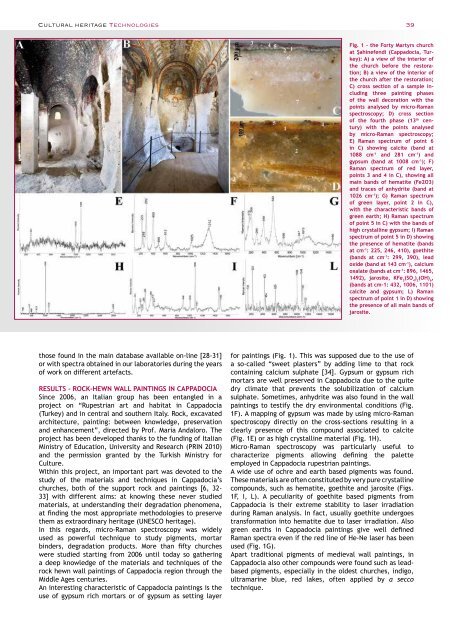Archeomatica International 2017
Special supplement to Archeomatica 3 2017
Special supplement to Archeomatica 3 2017
You also want an ePaper? Increase the reach of your titles
YUMPU automatically turns print PDFs into web optimized ePapers that Google loves.
Cultural heritage Technologies 39<br />
Fig. 1 - the Forty Martyrs church<br />
at Şahinefendi (Cappadocia, Turkey):<br />
A) a view of the interior of<br />
the church before the restoration;<br />
B) a view of the interior of<br />
the church after the restoration;<br />
C) cross section of a sample including<br />
three painting phases<br />
of the wall decoration with the<br />
points analysed by micro-Raman<br />
spectroscopy; D) cross section<br />
of the fourth phase (13 th century)<br />
with the points analysed<br />
by micro-Raman spectroscopy;<br />
E) Raman spectrum of point 6<br />
in C) showing calcite (band at<br />
1088 cm -1 and 281 cm -1 ) and<br />
gypsum (band at 1008 cm -1 ); F)<br />
Raman spectrum of red layer,<br />
points 3 and 4 in C), showing all<br />
main bands of hematite (Fe2O3)<br />
and traces of anhydrite (band at<br />
1026 cm -1 ); G) Raman spectrum<br />
of green layer, point 2 in C),<br />
with the characteristic bands of<br />
green earth; H) Raman spectrum<br />
of point 5 in C) with the bands of<br />
high crystalline gypsum; I) Raman<br />
spectrum of point 5 in D) showing<br />
the presence of hematite (bands<br />
at cm -1 : 225, 246, 410), goethite<br />
(bands at cm -1 : 299, 390), lead<br />
oxide (band at 143 cm -1 ), calcium<br />
oxalate (bands at cm -1 : 896, 1465,<br />
1492), jarosite, KFe 3<br />
(SO 4<br />
) 2<br />
(OH) 6<br />
,<br />
(bands at cm-1: 432, 1006, 1101)<br />
calcite and gypsum; L) Raman<br />
spectrum of point 1 in D) showing<br />
the presence of all main bands of<br />
jarosite.<br />
those found in the main database available on-line [28-31]<br />
or with spectra obtained in our laboratories during the years<br />
of work on different artefacts.<br />
RESULTS - ROCK-HEWN WALL PAINTINGS IN CAPPADOCIA<br />
Since 2006, an Italian group has been entangled in a<br />
project on “Rupestrian art and habitat in Cappadocia<br />
(Turkey) and in central and southern Italy. Rock, excavated<br />
architecture, painting: between knowledge, preservation<br />
and enhancement”, directed by Prof. Maria Andaloro. The<br />
project has been developed thanks to the funding of Italian<br />
Ministry of Education, University and Research (PRIN 2010)<br />
and the permission granted by the Turkish Ministry for<br />
Culture.<br />
Within this project, an important part was devoted to the<br />
study of the materials and techniques in Cappadocia’s<br />
churches, both of the support rock and paintings [6, 32-<br />
33] with different aims: at knowing these never studied<br />
materials, at understanding their degradation phenomena,<br />
at finding the most appropriate methodologies to preserve<br />
them as extraordinary heritage (UNESCO heritage).<br />
In this regards, micro-Raman spectroscopy was widely<br />
used as powerful technique to study pigments, mortar<br />
binders, degradation products. More than fifty churches<br />
were studied starting from 2006 until today so gathering<br />
a deep knowledge of the materials and techniques of the<br />
rock hewn wall paintings of Cappadocia region through the<br />
Middle Ages centuries.<br />
An interesting characteristic of Cappadocia paintings is the<br />
use of gypsum rich mortars or of gypsum as setting layer<br />
for paintings (Fig. 1). This was supposed due to the use of<br />
a so-called “sweet plasters” by adding lime to that rock<br />
containing calcium sulphate [34]. Gypsum or gypsum rich<br />
mortars are well preserved in Cappadocia due to the quite<br />
dry climate that prevents the solubilization of calcium<br />
sulphate. Sometimes, anhydrite was also found in the wall<br />
paintings to testify the dry environmental conditions (Fig.<br />
1F). A mapping of gypsum was made by using micro-Raman<br />
spectroscopy directly on the cross-sections resulting in a<br />
clearly presence of this compound associated to calcite<br />
(Fig. 1E) or as high crystalline material (Fig. 1H).<br />
Micro-Raman spectroscopy was particularly useful to<br />
characterize pigments allowing defining the palette<br />
employed in Cappadocia rupestrian paintings.<br />
A wide use of ochre and earth based pigments was found.<br />
These materials are often constituted by very pure crystalline<br />
compounds, such as hematite, goethite and jarosite (Figs.<br />
1F, I, L). A peculiarity of goethite based pigments from<br />
Cappadocia is their extreme stability to laser irradiation<br />
during Raman analysis. In fact, usually goethite undergoes<br />
transformation into hematite due to laser irradiation. Also<br />
green earths in Cappadocia paintings give well defined<br />
Raman spectra even if the red line of He-Ne laser has been<br />
used (Fig. 1G).<br />
Apart traditional pigments of medieval wall paintings, in<br />
Cappadocia also other compounds were found such as leadbased<br />
pigments, especially in the oldest churches, indigo,<br />
ultramarine blue, red lakes, often applied by a secco<br />
technique.


















